Experimental Evaluation of RC Structures with Brick Infills for Vertical Forest Adaptation in Seismic Regions
Abstract
1. Introduction
2. Methodology
2.1. Construction and Geometric Characteristics
2.2. Construction Materials
2.2.1. Concrete
2.2.2. Reinforcement
2.2.3. Bricks
2.3. Instrumentation
2.3.1. Accelerometer Configurations
2.3.2. Draw-Wire Meter Sensor Setup
2.3.3. Strain Gauge Distribution
2.3.4. Network of Advanced PZT Sensors
2.4. Input Seismic Signal
3. Results and Discussion
3.1. Acceleration Results
3.2. Draw-Wire Results
3.3. Strain Gauge Results
3.4. Infill Optical Damage Assessment
3.5. Assessment of the Structure Using Advanced PZTs Results
4. Conclusions
Author Contributions
Funding
Data Availability Statement
Conflicts of Interest
References
- Frangopol, D.M.; Tsompanakis, Y. (Eds.) Maintenance and Safety of Aging Infrastructure; Structures and Infrastructures Series; CRC Press: Boca Raton, FL, USA; Leiden, The Netherlands, 2014; ISBN 978-0-415-65942-0. [Google Scholar]
- Kim, J.-H.; Hessek, C.J.; Kim, Y.J.; Park, H.-G. Seismic Analysis, Design, and Retrofit of Built-Environments: A Procedural Review of Current Practices and Case Studies. J. Infrastruct. Preserv. Resil. 2022, 3, 11. [Google Scholar] [CrossRef]
- Ricci, P.; De Risi, M.T.; Verderame, G.M.; Manfredi, G. Influence of Infill Distribution and Design Typology on Seismic Performance of Low- and Mid-Rise RC Buildings. Bull. Earthq. Eng. 2013, 11, 1585–1616. [Google Scholar] [CrossRef]
- De Angelis, A.; Pecce, M.R. The Role of Infill Walls in the Dynamic Behavior and Seismic Upgrade of a Reinforced Concrete Framed Building. Front. Built Environ. 2020, 6, 590114. [Google Scholar] [CrossRef]
- Sattar, S.; Liel, A.B. Collapse Indicators for Existing Nonductile Concrete Frame Buildings with Varying Column and Frame Characteristics. Eng. Struct. 2017, 152, 188–201. [Google Scholar] [CrossRef]
- Jeon, J.-S.; Lowes, L.N.; DesRoches, R.; Brilakis, I. Fragility Curves for Non-Ductile Reinforced Concrete Frames That Exhibit Different Component Response Mechanisms. Eng. Struct. 2015, 85, 127–143. [Google Scholar] [CrossRef]
- Vintzileou, E.; Palieraki, V. Damage to Stone Masonry Buildings in Historical Centers Due to the 2023 Earthquake Sequence in Turkey. Earthq. Spectra 2024, 40, 2306–2338. [Google Scholar] [CrossRef]
- Puncello, I.; Caprili, S. Seismic Assessment of Historical Masonry Buildings at Different Scale Levels: A Review. Appl. Sci. 2023, 13, 1941. [Google Scholar] [CrossRef]
- Vuran, E.; Serhatoğlu, C.; Timurağaoğlu, M.Ö.; Smyrou, E.; Bal, İ.E.; Livaoğlu, R. Damage Observations of RC Buildings from 2023 Kahramanmaraş Earthquake Sequence and Discussion on the Seismic Code Regulations. Bull. Earthq. Eng. 2025, 23, 1153–1182. [Google Scholar] [CrossRef]
- Milijaš, A.; Marinković, M.; Butenweg, C.; Klinkel, S. Experimental Results of Reinforced Concrete Frames with Masonry Infills with and without Openings under Combined Quasi-Static in-Plane and out-of-Plane Seismic Loading. Bull. Earthq. Eng. 2023, 21, 3537–3579. [Google Scholar] [CrossRef]
- Milijaš, A.; Marinković, M.; Butenweg, C.; Klinkel, S. Experimental Investigation on the Seismic Performance of Reinforced Concrete Frames with Decoupled Masonry Infills: Considering in-Plane and out-of-Plane Load Interaction Effects. Bull. Earthq. Eng. 2024, 22, 7489–7546. [Google Scholar] [CrossRef]
- Baek, E.R.; Pohoryles, D.A.; Bournas, D. Seismic Assessment of the In-plane/Out-of-plane Interaction of Masonry Infills in a Two-storey RC Building Subjected to Bi-directional Shaking Table Tests. Earthq. Engng Struct. Dyn. 2024, 53, 2230–2251. [Google Scholar] [CrossRef]
- Palieraki, V.; Zeris, C.; Vintzileou, E.; Adami, C.-E. In-Plane and out-of Plane Response of Currently Constructed Masonry Infills. Eng. Struct. 2018, 177, 103–116. [Google Scholar] [CrossRef]
- Xie, X.; Qu, Z.; Fu, H.; Zhang, L. Effect of Prior In-Plane Damage on the out-of-Plane Behavior of Masonry Infill Walls. Eng. Struct. 2021, 226, 111380. [Google Scholar] [CrossRef]
- Liu, W.; Jin, W.; Zhai, C. Fragility Functions for Masonry Infill Walls in RC Frames with the In-Plane and Out-of-Plane Loading. J. Build. Eng. 2024, 95, 110177. [Google Scholar] [CrossRef]
- Mouloud, H.; Chaker, A.; Nassim, H.; Lebdioui, S.; Rodrigues, H.; Agius, M.R. Post-Earthquake Damage Classification and Assessment: Case Study of the Residential Buildings after the Mw = 5 Earthquake in Mila City, Northeast Algeria on August 7, 2020. Bull. Earthq. Eng. 2023, 21, 849–891. [Google Scholar] [CrossRef] [PubMed]
- Harirchian, E.; Lahmer, T.; Buddhiraju, S.; Mohammad, K.; Mosavi, A. Earthquake Safety Assessment of Buildings through Rapid Visual Screening. Buildings 2020, 10, 51. [Google Scholar] [CrossRef]
- López-Castro, B.; Haro-Baez, A.G.; Arcos-Aviles, D.; Barreno-Riera, M.; Landázuri-Avilés, B. A Systematic Review of Structural Health Monitoring Systems to Strengthen Post-Earthquake Assessment Procedures. Sensors 2022, 22, 9206. [Google Scholar] [CrossRef]
- Fuentes, R.; Cross, E.J.; Gardner, P.A.; Bull, L.A.; Rogers, T.J.; Barthorpe, R.J.; Shi, H.; Dervilis, N.; Farrar, C.R.; Worden, K. Structural Health Monitoring and Damage Identification. In Handbook of Experimental Structural Dynamics; Springer: New York, NY, USA, 2020; pp. 1–72. ISBN 978-1-4939-6503-8. [Google Scholar]
- Voutetaki, M.E.; Providakis, C.P.; Chalioris, C.E. FRP Debonding Prevention of Strengthened Concrete Members under Dynamic Load Using Smart Piezoelectric Materials (PZT). In Proceedings of the 15th European Conference on Composite Materials (ECCM15), Venice, Italy, 24–28 June 2012; p. 2170. [Google Scholar]
- Naoum, M.C.; Papadopoulos, N.A.; Sapidis, G.M.; Voutetaki, M.E. Efficacy of PZT Sensors Network Different Configurations in Damage Detection of Fiber-Reinforced Concrete Prisms under Repeated Loading. Sensors 2024, 24, 5660. [Google Scholar] [CrossRef]
- Liang, Y.; Li, C.; Liu, Z.; Wang, X.; Zeng, F.; Yuan, X.; Pan, Y. Decarbonization Potentials of the Embodied Energy Use and Operational Process in Buildings: A Review from the Life-Cycle Perspective. Heliyon 2023, 9, e20190. [Google Scholar] [CrossRef]
- Pohoryles, D.A.; Bournas, D.A.; Da Porto, F.; Caprino, A.; Santarsiero, G.; Triantafillou, T. Integrated Seismic and Energy Retrofitting of Existing Buildings: A State-of-the-Art Review. J. Build. Eng. 2022, 61, 105274. [Google Scholar] [CrossRef]
- Shafique, M.; Xue, X.; Luo, X. An Overview of Carbon Sequestration of Green Roofs in Urban Areas. Urban For. Urban Green. 2020, 47, 126515. [Google Scholar] [CrossRef]
- Theodoridou, I.; Vatitsi, K.; Stefanidou, M.; Vanian, V.; Fanaradelli, T.; Macha, M.; Zapris, A.; Kytinou, V.; Voutetaki, M.; Rousakis, T.; et al. Nature-Based Solutions for Urban Buildings—The Potential of Vertical Greenery: A Brief Review of Benefits and Challenges of Implementation. Urban. Sci. 2025, 9, 398. [Google Scholar] [CrossRef]
- Vanian, V.; Rousakis, T.; Fanaradelli, T.; Voutetaki, M.; Macha, M.; Zapris, A.; Theodoridou, I.; Stefanidou, M.; Vatitsi, K.; Mallinis, G.; et al. Performance-Based Damage Quantification and Hazard Intensity Measures for Vertical Forest Systems on RC Buildings. Buildings 2025, 15, 769. [Google Scholar] [CrossRef]
- Vanian, V.; Fanaradelli, T.; Rousakis, T. A Comprehensive Review of Vertical Forest Buildings: Integrating Structural, Energy, Forestry, and Occupant Comfort Aspects in Renovation Modeling. Fibers 2025, 13, 101. [Google Scholar] [CrossRef]
- EN 1992-1-1:2004; Eurocode 2: Design of Concrete Structures—Part 1-1: General Rules and Rules for Buildings. European Committee for Standardization: Brussels, Belgium, 2004.
- EN 12390-3:2019; Testing Hardened Concrete—Part 3: Compressive Strength of Test Specimens. European Committee for Standardization: Brussels, Belgium, 2019.
- EN 12390-6:2023; Testing Hardened Concrete—Part 6: Tensile Splitting Strength of Test Specimens. European Committee for Standardization: Brussels, Belgium, 2023.
- Rousakis, T.; Ilki, A.; Kwiecien, A.; Viskovic, A.; Gams, M.; Triller, P.; Ghiassi, B.; Benedetti, A.; Rakicevic, Z.; Colla, C.; et al. Deformable Polyurethane Joints and Fibre Grids for Resilient Seismic Performance of Reinforced Concrete Frames with Orthoblock Brick Infills. Polymers 2020, 12, 2869. [Google Scholar] [CrossRef]
- Voutetaki, M.E.; Naoum, M.C.; Papadopoulos, N.A.; Chalioris, C.E. Cracking Diagnosis in Fiber-Reinforced Concrete with Synthetic Fibers Using Piezoelectric Transducers. Fibers 2022, 10, 5. [Google Scholar] [CrossRef]
- Voutetaki, M.E.; Papadopoulos, N.A.; Angeli, G.M.; Providakis, C.P. Investigation of a New Experimental Method for Damage Assessment of RC Beams Failing in Shear Using Piezoelectric Transducers. Eng. Struct. 2016, 114, 226–240. [Google Scholar] [CrossRef]
- Chalioris, C.E.; Voutetaki, M.E.; Liolios, A.A. Structural Health Monitoring of Seismically Vulnerable RC Frames under Lateral Cyclic Loading. Earthq. Struct. 2020, 19, 29–44. [Google Scholar] [CrossRef]
- Karayannis, C.G.; Golias, E.; Naoum, M.C.; Chalioris, C.E. Efficacy and Damage Diagnosis of Reinforced Concrete Columns and Joints Strengthened with FRP Ropes Using Piezoelectric Transducers. Sensors 2022, 22, 8294. [Google Scholar] [CrossRef]
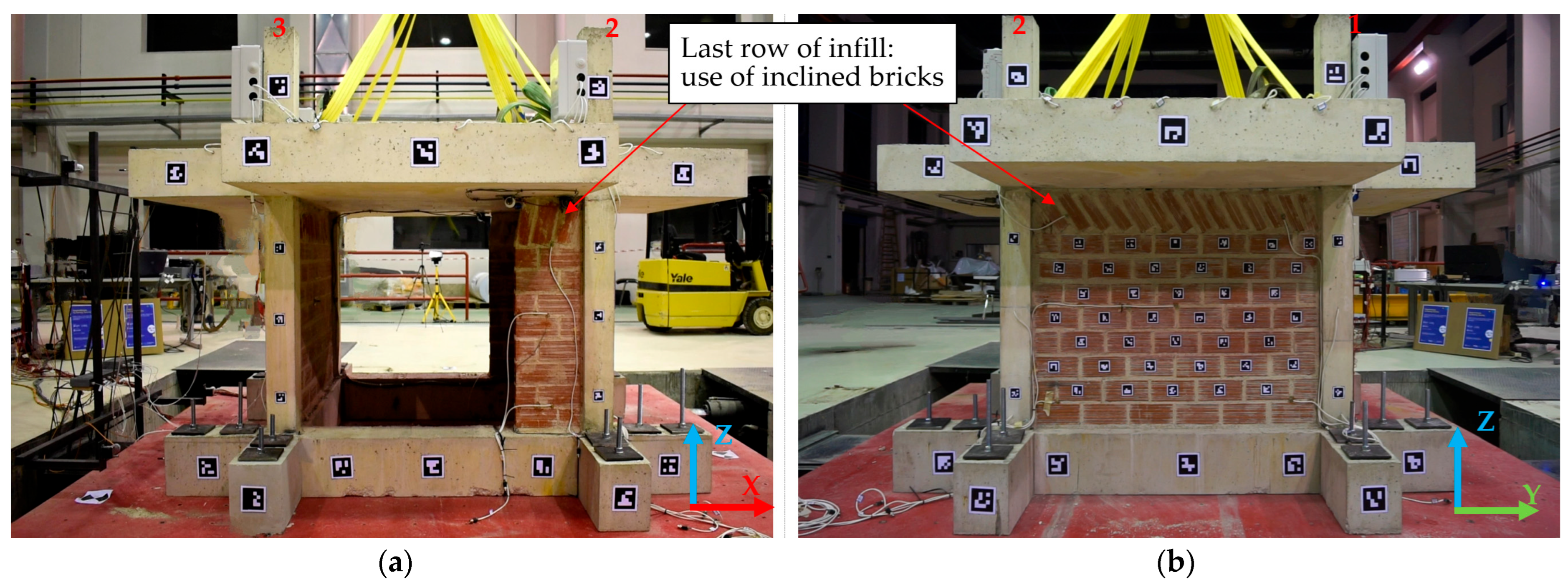


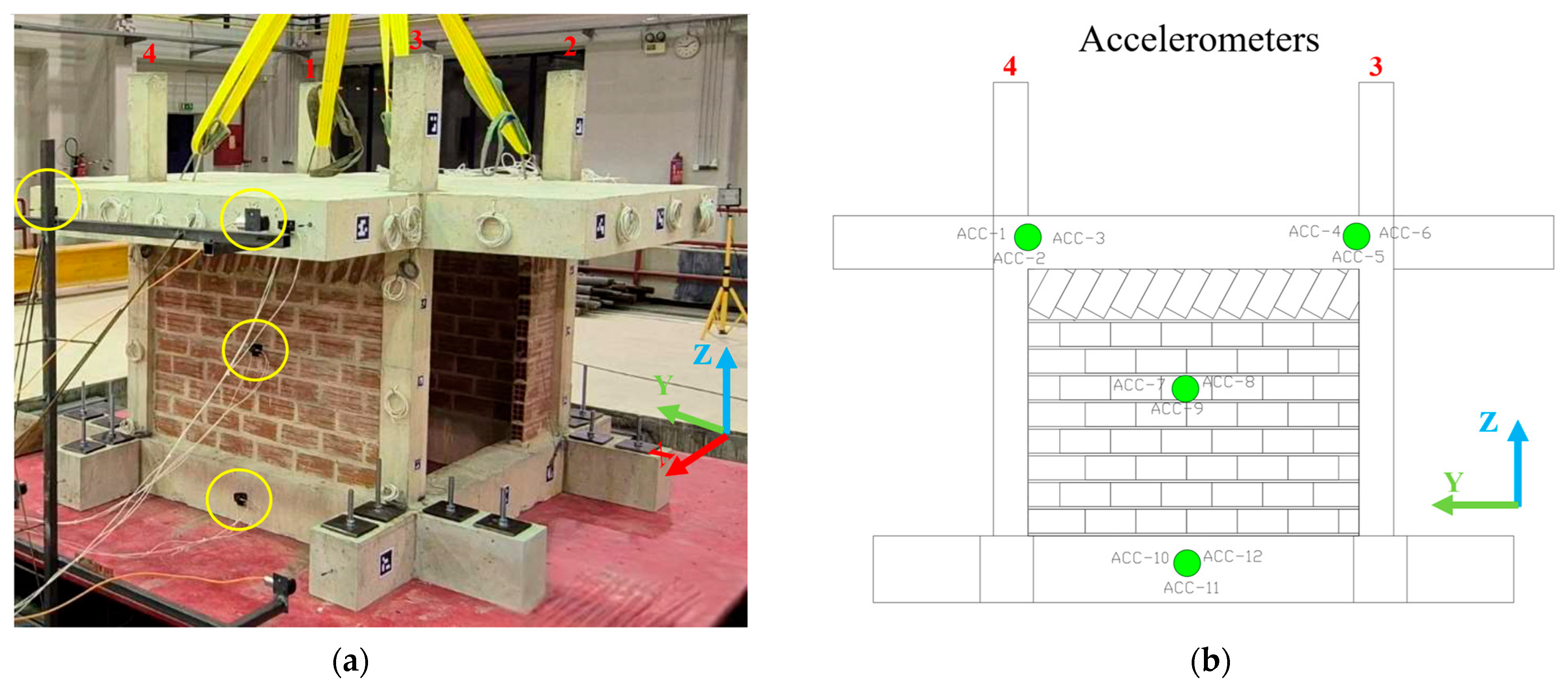
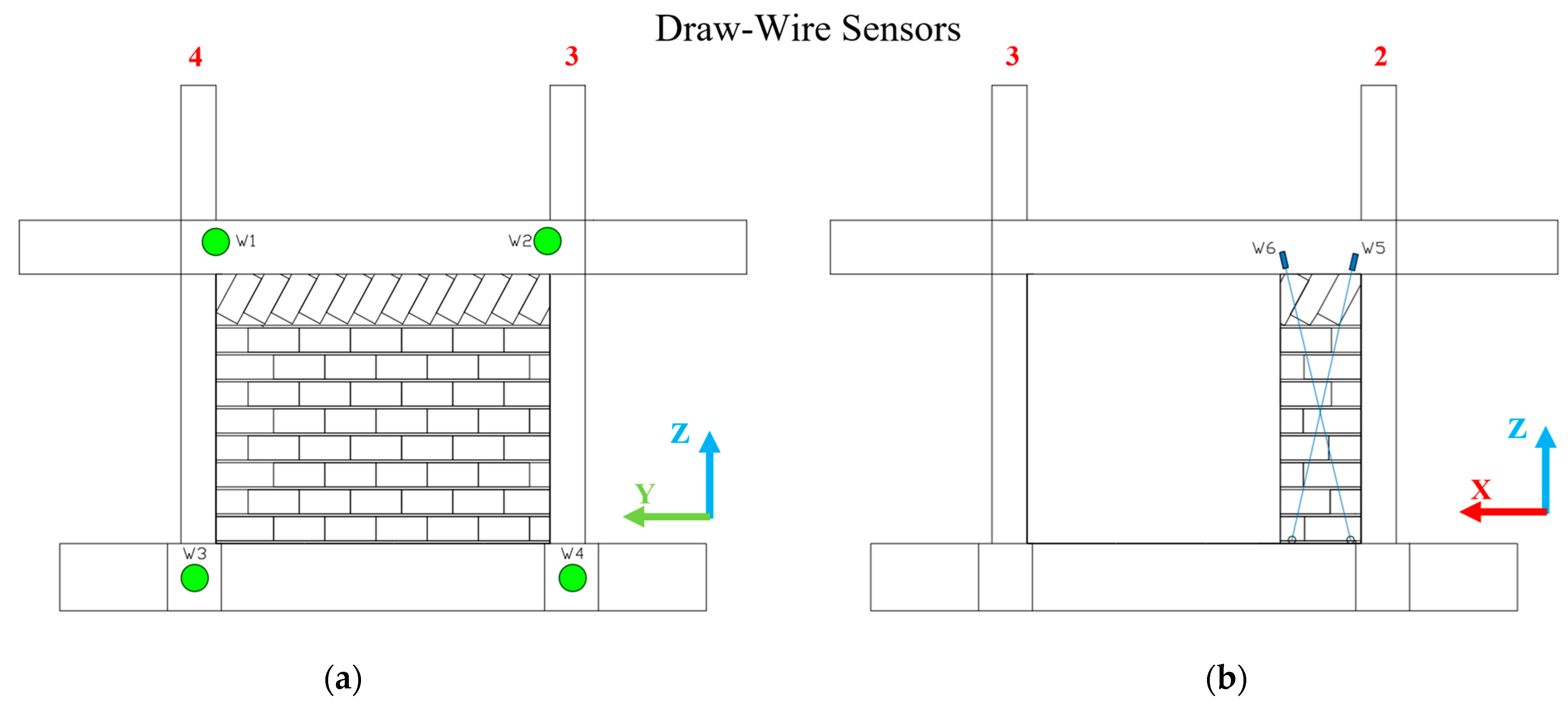



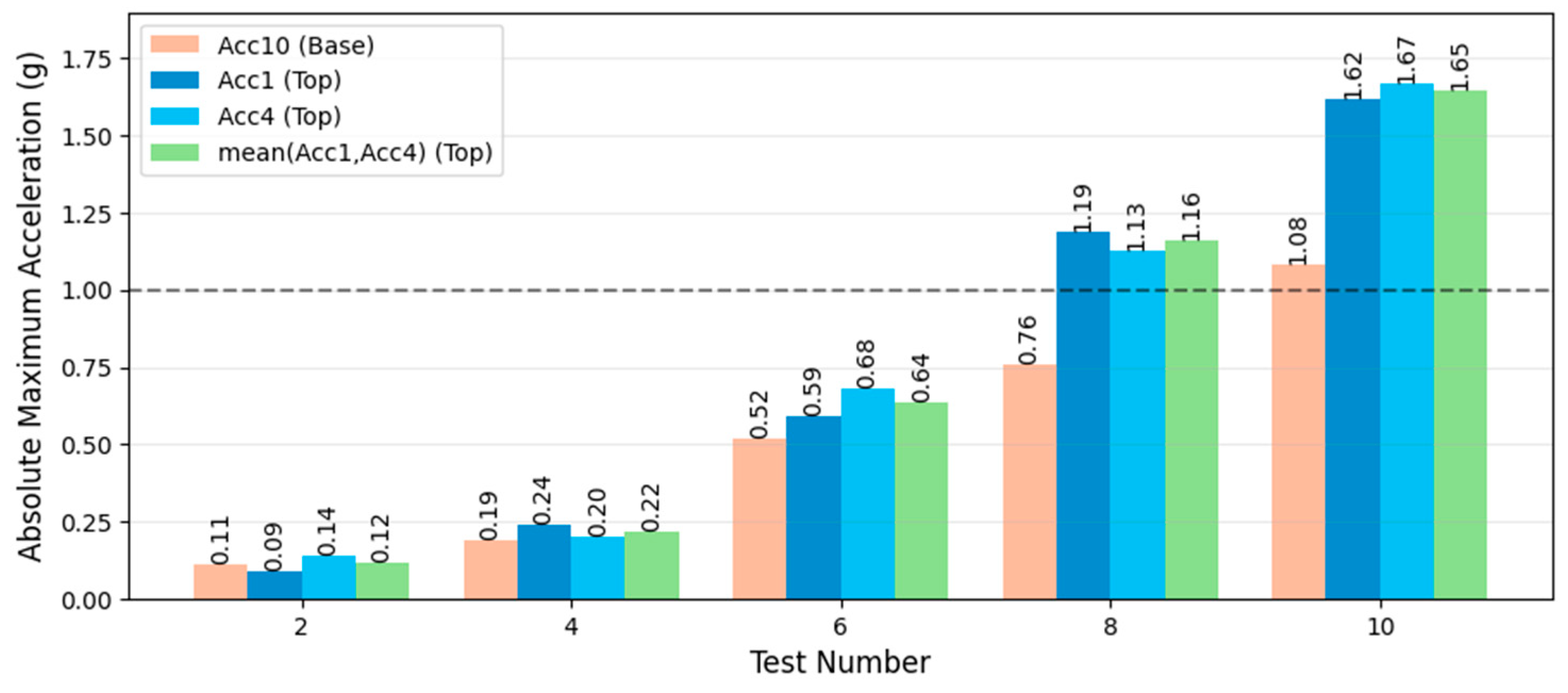
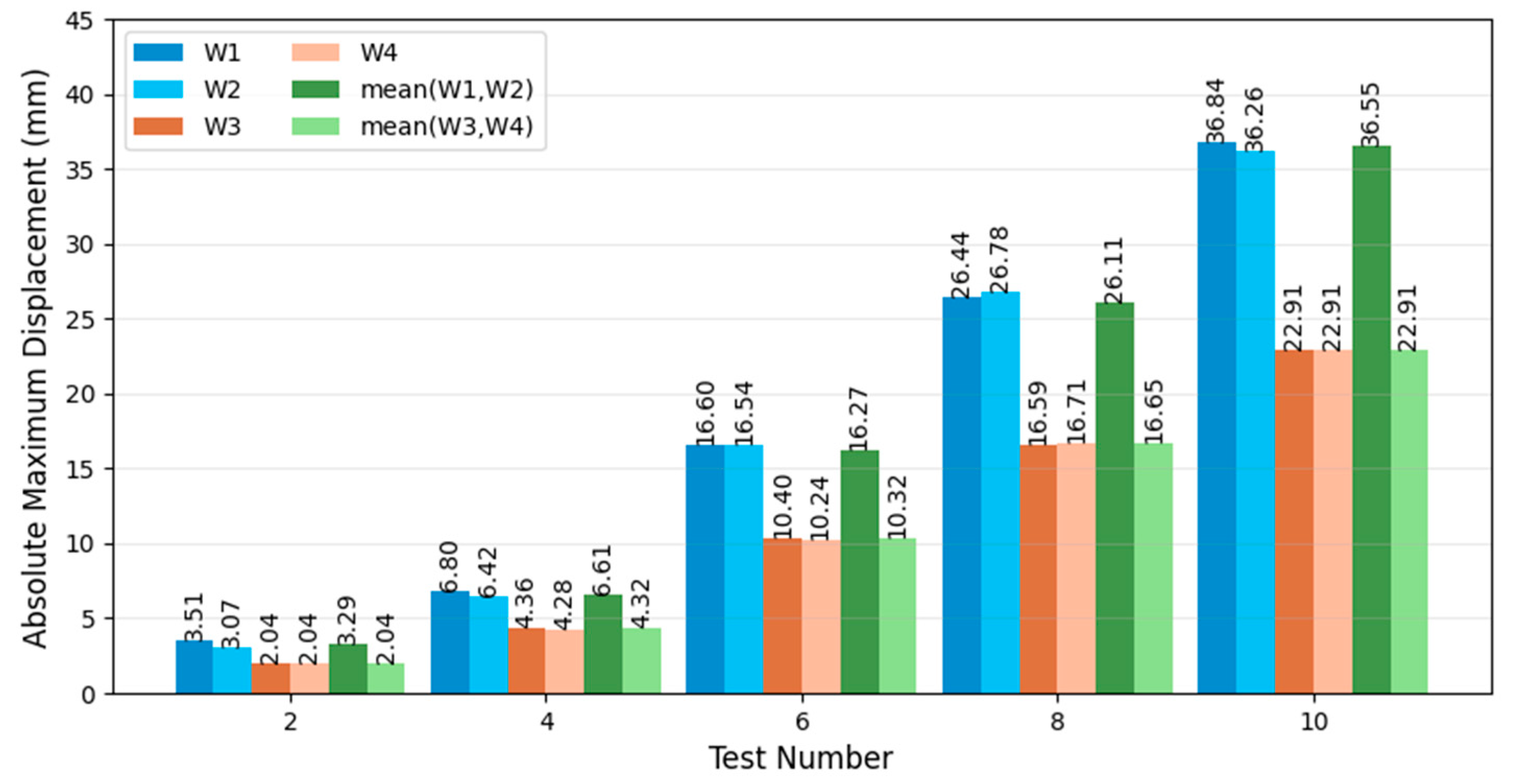
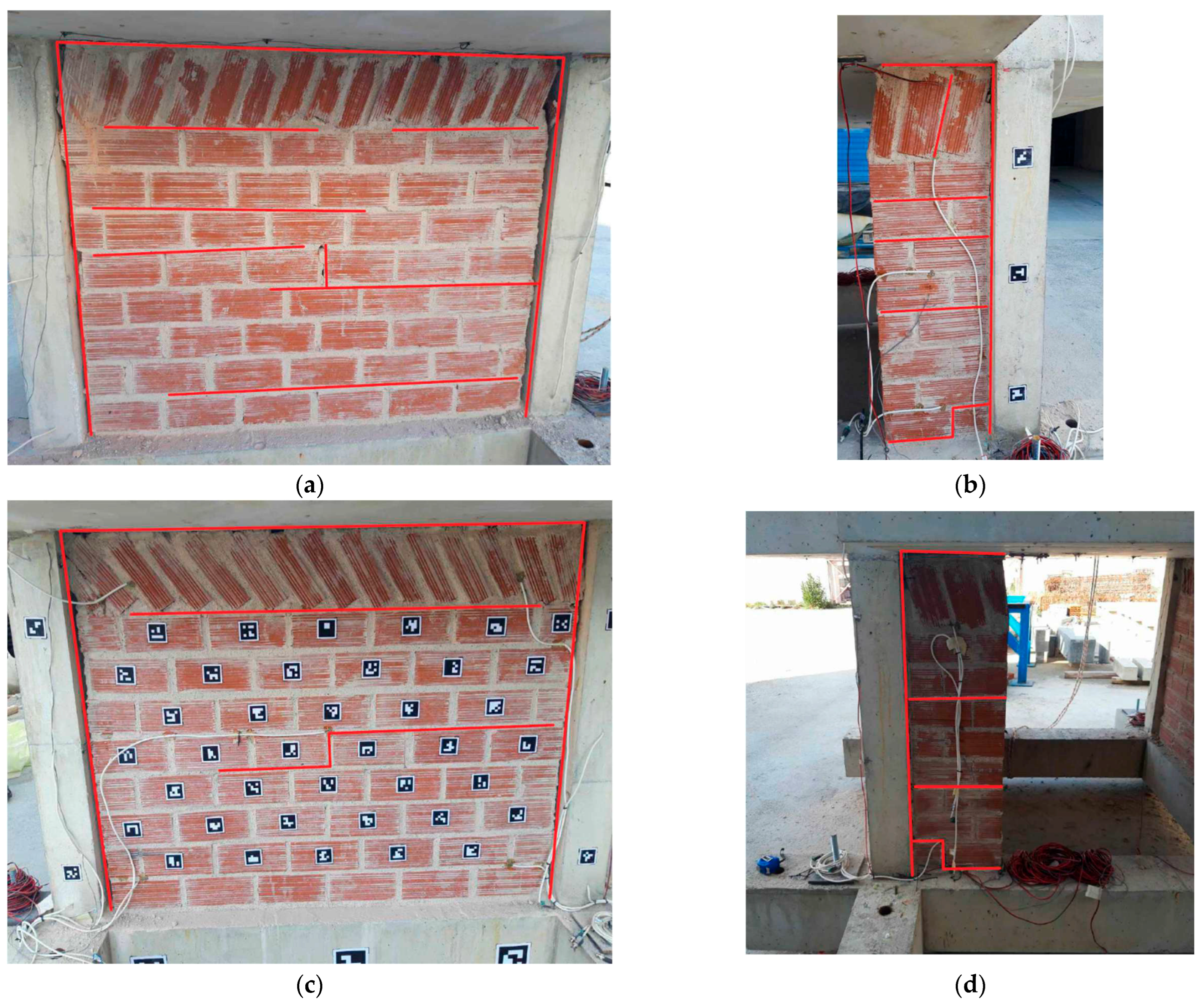
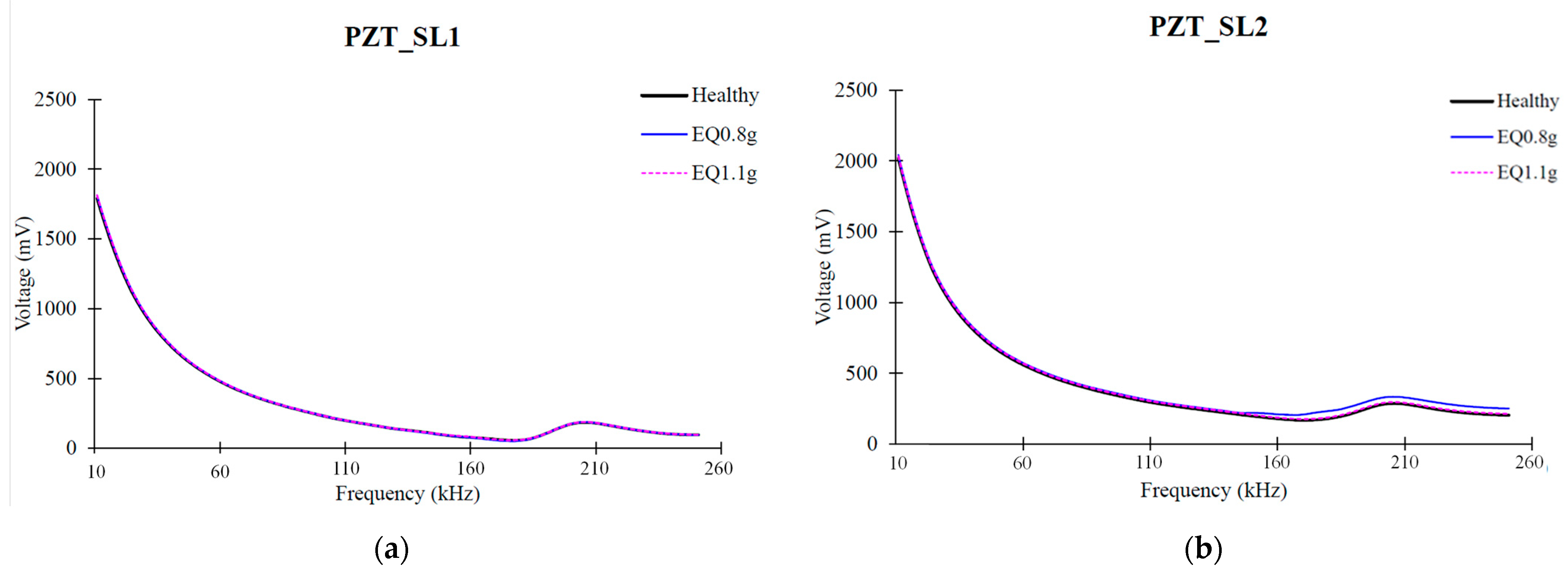

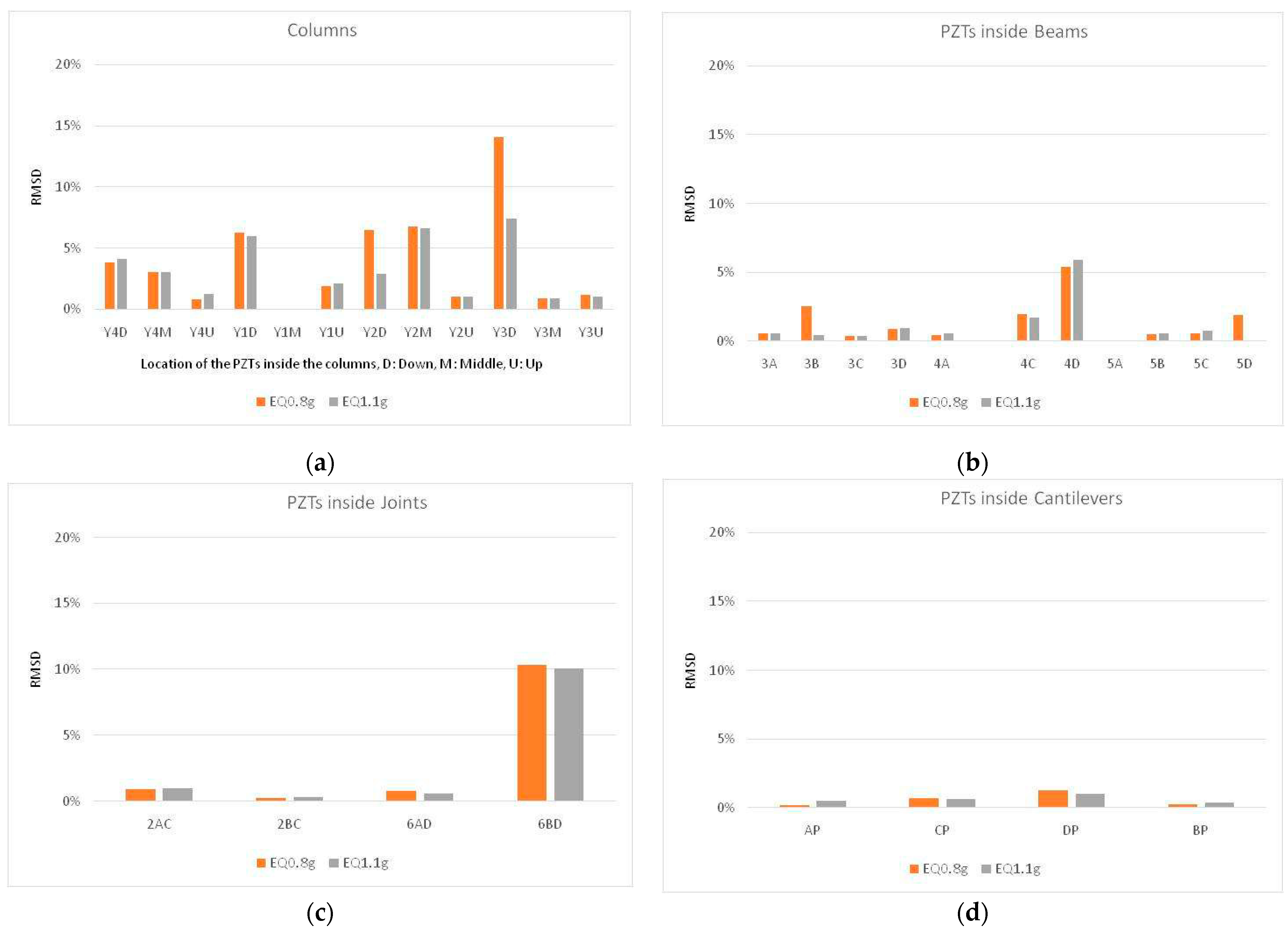

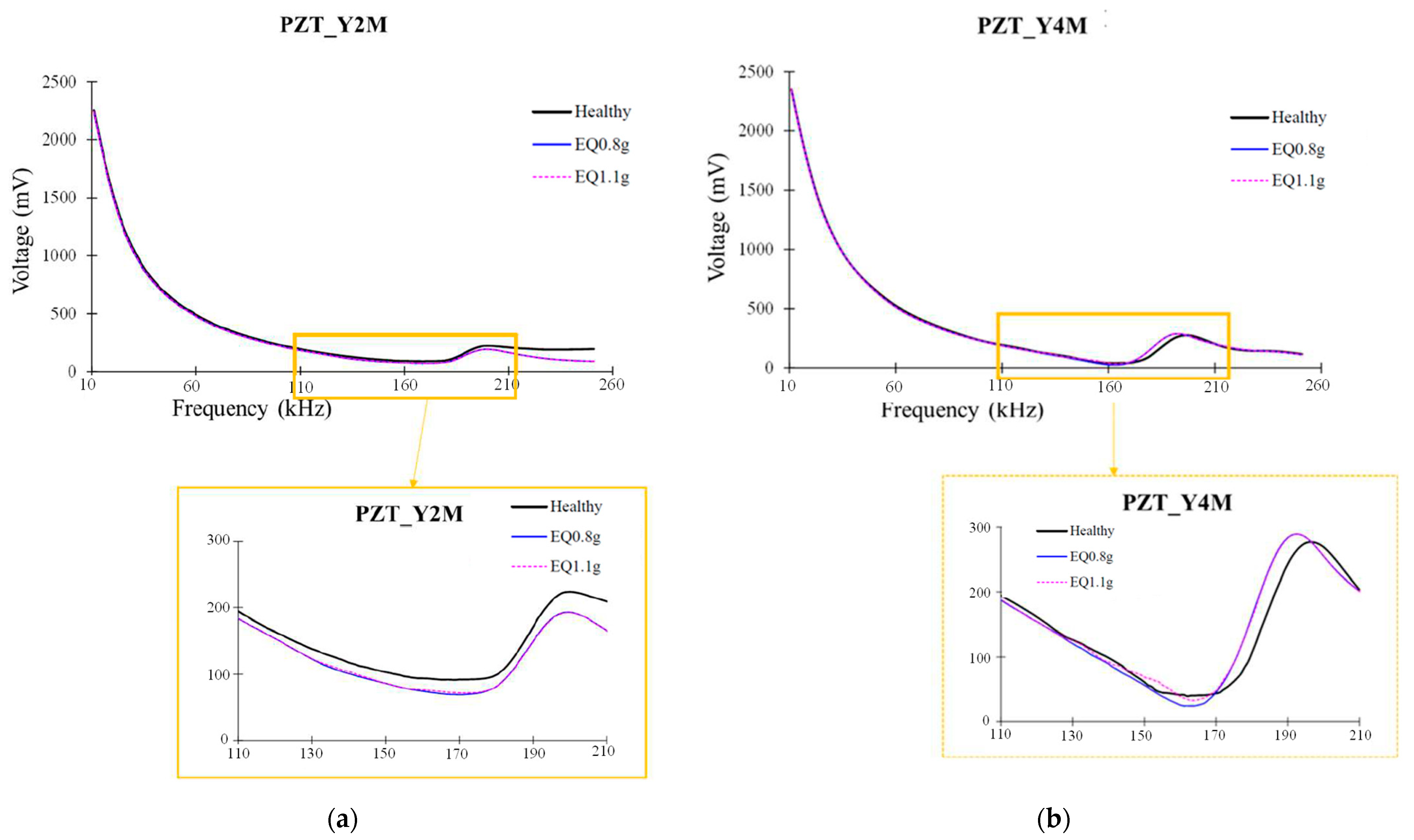
| Structural Element | Mix Proportions (kg/m3) | Compressive Strength (MPa) | Average (MPa) | * CV (%) | |||
|---|---|---|---|---|---|---|---|
| Cement | Water | Sand | Aggregate | ||||
| Tie Beam | *** 320 | 171 | 1003 | 855 | 36.06, 36.44, 37.79 | 36.76 | 2.5 |
| ** Column | 300 | 199 | 1024 | 798 | 24.52, 20.92, 25.13 | 23.52 | 9.7 |
| Slab | 300 | 199 | 1024 | 798 | 32.13, 30.68, 32.87, 30.82, 31.67 | 31.63 | 2.9 |
| Structural Element | Longitudinal Reinforcement | Transverse Reinforcement | Bar Grade | Total Steel Weight (kg) |
|---|---|---|---|---|
| Foundation beams | 8Ø14 mm | Ø10/100 mm | B500C | 132.1 |
| Columns (below slab) | 4Ø8 mm | Ø5.5/60 mm | B500C/S220 | 19.6 |
| Columns (above slab) | 4Ø8 mm | Ø5.5/60 mm | B500C/S220 | 7.7 |
| Hidden beams | 8Ø10 mm | Ø10/100 mm | B500C | 109.9 |
| Slab | Ø8/100 mm (top and bottom) | - | B500C | 121 |
| Total steel weight | 390.3 |
| Property | Symbol | Value | Unit |
|---|---|---|---|
| Yield strength | fsy | 564 | MPa |
| Ultimate strength | fsu | 663 | MPa |
| Elastic modulus | Es | 195,156 | MPa |
| Yield strain | εsy | 0.289 | % |
| Ultimate strain | εsu | 14.3 | % |
| Property | Specification | 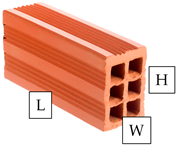 |
| Manufacturer | KEBE S.A. | |
| Type | Hollow clay brick | |
| Dimensions | 60 × 90 × 190 mm (W × H × L) | |
| Weight per brick | 1.2 kg | |
| Void percentage | 45.00% | |
| Joints thickness | 10 mm horizontal, 10 mm vertical |
| Sensor Type | Manufacturer | Model | Range | Sensitivity |
|---|---|---|---|---|
| Accelerometer | KISTLER (Winterthur, Switzerland) | 8330A3 | ±3 g | 1200 mV/g (±10% tolerance) |
| Draw-wire | WayCon (Munich, Germany) | SX50-300-10V-KA05 | ±300 mm | ±0.02% of full scale |
| Strain gauge | Tokyo Measuring Instruments Lab. (Tokyo, Japan) | FLAB-5-11-3LJC-F | 5 mm | 2.10 ± 1% (gauge factor) |
| PZT sensor (PZT transducer) | PI Ceramics (Thuringia, Germany) | PIC 151 | 10–250 Hz | 1 Hz |
| Test No. | Name | Type | Intensity | Test No. | Name | Type | Intensity |
|---|---|---|---|---|---|---|---|
| ST1 | WNb0.1g | White noise | 0.08 g | ST7 | WNb0.8g | White noise | 0.08 g |
| ST2 | EQ0.1g | Earthquake | 0.10 g | ST8 | EQ0.8g | Earthquake | 0.80 g |
| ST3 | WNb0.2g | White noise | 0.08 g | ST9 | WNb1.1g | White noise | 0.08 g |
| ST4 | EQ0.2g | Earthquake | 0.20 g | ST10 | EQ1.1g | Earthquake | 1.10 g |
| ST5 | WNb0.5g | White noise | 0.08 g | ST11 | WNa1.1g | White noise | 0.08 g |
| ST6 | EQ0.5g | Earthquake | 0.50 g |
| Test No. | PGA (g) | PFA (g) | FAF | Test No. | PGA (g) | PFA (g) | FAF |
|---|---|---|---|---|---|---|---|
| ST1 | +0.13/−0.13 | +0.11/−0.13 | 1.00 | ST7 | +0.06/−0.08 | +0.25/−0.24 | 3.13 |
| ST2 | +0.07/−0.11 | +0.14/−0.09 | 1.27 | ST8 | +0.69/−0.76 | +1.19/−1.13 | 1.57 |
| ST3 | +0.1/−0.11 | +0.12/−0.12 | 1.09 | ST9 | +0.06/−0.07 | +0.12/−0.13 | 1.86 |
| ST4 | +0.15/−0.19 | +0.24/−0.2 | 1.26 | ST10 | +1.08/−1.00 | +1.67/−1.62 | 1.55 |
| ST5 | +0.06/−0.07 | +0.11/−0.11 | 1.57 | ST11 | +0.06/−0.09 | +0.19/−0.19 | 2.11 |
| ST6 | +0.47/−0.52 | +0.68/−0.59 | 1.31 |
| Test No. | Disp. (mm) | Drift (‰) | Test No. | Disp. (mm) | Drift (‰) |
|---|---|---|---|---|---|
| ST1 | +1.35/−1.35 | +1.10/−1.10 | ST7 | +2.81/−2.84 | +2.29/−2.32 |
| ST2 | +1.47/−1.03 | +1.20/−0.84 | ST8 | +9.85/−10.07 | +8.04/−8.22 |
| ST3 | +1.32/−1.18 | +1.08/−0.96 | ST9 | +1.62/−1.58 | +1.32/−1.29 |
| ST4 | +2.44/−2.14 | +1.99/−1.75 | ST10 | +13.93/−13.35 | +11.37/−10.9 |
| ST5 | +1.24/−1.08 | +1.01/−0.88 | ST11 | +2.82/−2.83 | +2.30/−2.31 |
| ST6 | +6.20/−6.30 | +5.06/−5.14 |
| Location | Gauge ID | Max Tensile (μstrain) | Max Comp. (μstrain) | Residual (μstrain) | Test Stage (First > 1000 μstrain) |
|---|---|---|---|---|---|
| Column 1 | |||||
| Bottom | SG1 | 1190 | −336 | −15 | ST10 |
| SG2 | 809 | −92 | −15 | — | |
| Top | SG9 | 1979 | −56 | 717 | ST8 |
| SG10 | 1962 | −269 | −54 | ST8 | |
| Column 2 | |||||
| Bottom | SG5 | 2335 | −1136 | −412 | ST8 |
| SG6 | 1764 | −74 | −50 | ST8 | |
| Top | SG11 | 1068 | −198 | −31 | ST10 |
| SG12 | 855 | −76 | −1 | — | |
| Column 3 | |||||
| Bottom | SG3 | 702 | −92 | 31 | — |
| SG4 | 1205 | −427 | −76 | ST10 | |
| Top | SG13 | 1007 | −92 | 0 | ST10 |
| SG14 | 1083 | −198 | 0 | ST10 | |
| Column 4 | |||||
| Bottom | SG7 | 702 | −46 | −83 | — |
| SG8 | 1129 | −446 | −92 | ST10 | |
| Top | SG15 | 1175 | −259 | 0 | ST10 |
| SG16 | 839 | −137 | 0 | — | |
| Infills | |||||
| Partial 1 | SG17 | 76 | −107 | −61 | — |
| SG18 | 92 | −92 | 46 | — | |
| Partial 2 | SG19 | 30 | −52 | 2 | — |
| SG20 | 51 | −94 | 12 | — |
Disclaimer/Publisher’s Note: The statements, opinions and data contained in all publications are solely those of the individual author(s) and contributor(s) and not of MDPI and/or the editor(s). MDPI and/or the editor(s) disclaim responsibility for any injury to people or property resulting from any ideas, methods, instructions or products referred to in the content. |
© 2025 by the authors. Licensee MDPI, Basel, Switzerland. This article is an open access article distributed under the terms and conditions of the Creative Commons Attribution (CC BY) license (https://creativecommons.org/licenses/by/4.0/).
Share and Cite
Rousakis, T.; Vanian, V.; Lappa, M.; Zapris, A.G.; Xynopoulos, I.P.; Voutetaki, M.; Kellis, S.; Sapidis, G.; Naoum, M.; Papadopoulos, N.; et al. Experimental Evaluation of RC Structures with Brick Infills for Vertical Forest Adaptation in Seismic Regions. Fibers 2025, 13, 154. https://doi.org/10.3390/fib13110154
Rousakis T, Vanian V, Lappa M, Zapris AG, Xynopoulos IP, Voutetaki M, Kellis S, Sapidis G, Naoum M, Papadopoulos N, et al. Experimental Evaluation of RC Structures with Brick Infills for Vertical Forest Adaptation in Seismic Regions. Fibers. 2025; 13(11):154. https://doi.org/10.3390/fib13110154
Chicago/Turabian StyleRousakis, Theodoros, Vachan Vanian, Martha Lappa, Adamantis G. Zapris, Ioannis P. Xynopoulos, Maristella Voutetaki, Stefanos Kellis, George Sapidis, Maria Naoum, Nikos Papadopoulos, and et al. 2025. "Experimental Evaluation of RC Structures with Brick Infills for Vertical Forest Adaptation in Seismic Regions" Fibers 13, no. 11: 154. https://doi.org/10.3390/fib13110154
APA StyleRousakis, T., Vanian, V., Lappa, M., Zapris, A. G., Xynopoulos, I. P., Voutetaki, M., Kellis, S., Sapidis, G., Naoum, M., Papadopoulos, N., Kytinou, V. K., Karabini, M., Chalioris, C. E., Thomoglou, A. K., & Golias, E. (2025). Experimental Evaluation of RC Structures with Brick Infills for Vertical Forest Adaptation in Seismic Regions. Fibers, 13(11), 154. https://doi.org/10.3390/fib13110154















